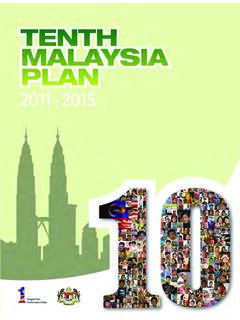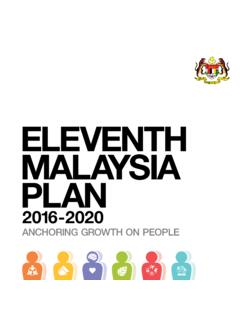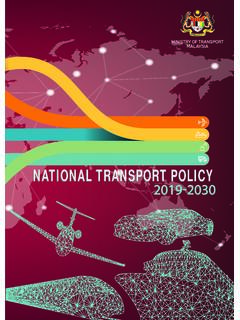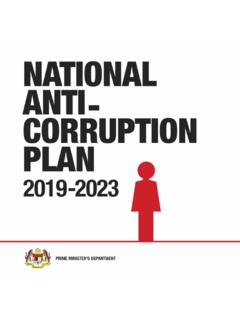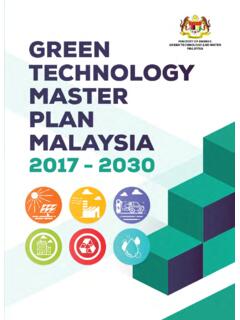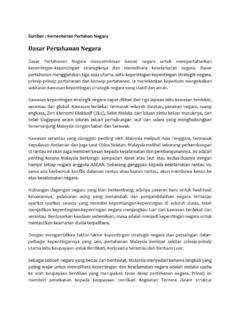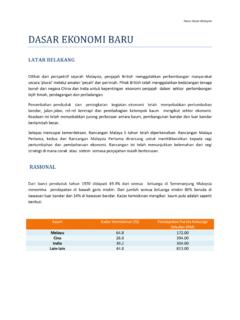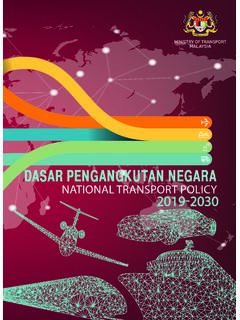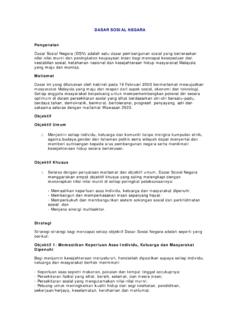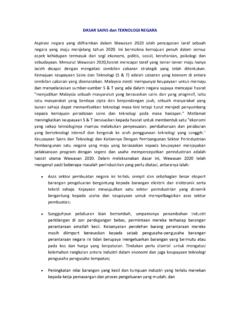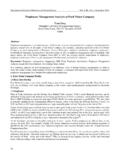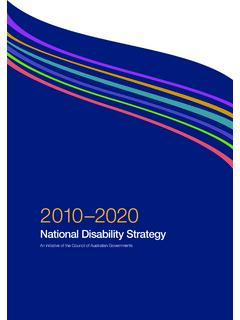Transcription of NEW ECONOMIC MODEL FOR MALAYSIA pART 1
1 NATIONAL ECONOMIC ADVISORY COUNCILNEW ECONOMIC MODEL FOR MALAYSIApART 1 RakyatQuality of LifeHigh IncomeInclusivenessSustainabilityNEACN ational ECONOMIC Advisory CouncilLevel 5 & 11, Menara UsahawanPersiaran Perdana, Precinct 2 Federal Government Administrative Centre62652 PUTRAJAYA 1 NEW ECONOMIC MODEL FOR MALAYSIA NEACJD132294 MPEN BI 13/20/10 4:53:12 PMCHAPTRE1 NEW ECONOMIC MODELFOR MALAYSIAPart I: Strategic Policy DirectionsNEACNATIONAL ECONOMIC ADVISORY COUNCILJD132294 Title 13/20/10 4:48:43 PMCopyrights ReservedAll rights reserved. No part of this publication may be reproduced, stored in retrieval system or transmitted in any form or by any means electronic, mechanical, photocopying, recording and/or otherwise without the prior permission of: SecretaryNational ECONOMIC Advisory CouncilLevel 5 & 11, Menara UsahawanPersiaran Perdana, Precinct 2 Federal Government Administrative Centre62652 PUTRAJAYATel.
2 : 03-8888 6512/ 8888 6513 Fax: 03-8888 4638/ 8888 4177 Email: copies are obtainable from: Percetakan Nasional MALAYSIA BerhadJalan Chan Sow Lin 50554 Kuala Lumpur Tel.: 03-9236 6888 Fax: 03-9222 4773 Email: design and layout by Percetakan Nasional MALAYSIA Berhad JD132294 Title 23/20/10 4:48:43 PMiiiThis report is the first of two documents by the National ECONOMIC Advisory Council (NEAC) on the New ECONOMIC MODEL (NEM). This report presents an overall framework of the NEM for transforming MALAYSIA from a middle income to an advanced nation by 2020. It was developed following a series of meetings of the NEAC beginning in 2009 and consultations with stakeholders in the business sector, government, labour unions, academia and others. It is intended that this report will serve as the basis for formulating the policy measures and the implementation plan in the final document that follows.
3 The independent work of the NEAC is an important component of the government s 1 MALAYSIA concept and programme. The NEM will define the Strategic Reform Initiatives (SRIs) that will propel MALAYSIA to the goals first set forth in Vision 2020. In the Budget 2010 Speech in October 2009, the Prime Minister and Minister of Finance, YAB Dato Sri Mohd. Najib Tun Abdul Razak, emphasised high-skilled human capital, efficient public services, a reinvigorated private sector and equal opportunity for all Malaysians. The NEAC embraces these themes in the NEM. The rest of the report is structured as follows. PrefaceChapter 1: Why Do We Need the NEM and What Are Its Goals? briefly presents the goals and characteristics of the NEM.
4 It also touches on the enabling actions and the bold policy measures underlying the Strategic Reform initiatives (SRIs) of the ECONOMIC Transformation Programme (ETP) to deliver the goals of the NEM. Chapter 2: Where Are We? sets forth M a l a y s i a s c u r r e n t p o s i t i o n a n d t h e challenges we face going forward. In the aftermath of the Asian financial crisis the country has posted mediocre and subdued growth recovery, mainly attributed to low and stagnant private investment. While the export sector is an important growth driver, outputs are mainly low value added, reflecting a lack of innovation, a low-skilled labour force, and conditions that constrain business development. Commodities, which have benefited from price increases during the last half-decade, form the bulk of the remaining 3: What Is Happening Around Us?
5 Focusses on the much more challenging environment within which MALAYSIA must manage its affairs, in particular its ECONOMIC management. The global landscape is changing with leading countries exhibiting a new set of distinguishing characteristics; governments responding more rapidly to JD132294 33/20/10 4:50:20 PMiveconomic pressures; environmental issues driving policy considerations and competitive advantages; profits and productivity being driven by openness and leveraging networks; and human capital advancing and flowing between global markets more readily. Chapter 4: Which Advantages Do We Have? highlights some of the strengths that have contributed towards MALAYSIA s past successes and new ones that it can leverage to meet its present challenges.
6 The country s advantages include its diverse population, rich biodiversity and resources, strategic location in a high growth region, a well-established manufacturing base and an attractive standard of living in urban areas. Chapter 5: Where Do We Want To Be? describes in detail the main objectives of the New ECONOMIC MODEL . MALAYSIA wants to be a developed and competitive economy whose people enjoy a high quality of life having attained a high level of income which is the result of growth that is both inclusive and sustainable by 2020. Chapter 6: How Do We Get There? s e t s f o r t h t h e t r a n s f o r m a t i o n j o u r n e y for the economy; the policy measures, institutional and regulatory reforms to reshape the incentive structures to deliver the eventual outcomes.
7 This will require political leadership to effect the necessary push anchored by a set of strategic policy initiatives. Finally, Chapter 7: The Time for Change Is Now MALAYSIA Deserves No Less outlines the next steps with regard to the development of specific measures for the 43/20/10 4:50:20 PMvi_____Tan Sri Amirsham A. AzizChairman_____Prof. Tan Sri Dzulkifli Abdul RazakMember_____Datuk Dr. Hamzah Kassim Member_____Dr. Yukon HuangMember_____Dr. Homi J. KharasMember_____Datuk Dr. Mahani Zainal AbidinMember_____Prof. Dr. Danny Quah Member_____Datuk Seri Panglima Andrew ShengMember_____Datuk Dr. Zainal Aznam Mohd YusofMember_____Datuk Nicholas S. Zefferys MemberJD132294 63/20/10 4:50:24 PMviiContentsExecutive Summary 1 1. Why do we need the NEM and what are its goals?
8 31 Goals of the NEM 35 Enabling the NEM 362. Where are we? 39 MALAYSIA is open for better and for worse 42 The ECONOMIC engine is slowing 44 Private investors have taken a back seat 45 Doing business in MALAYSIA is still too difficult 47 Our exports are still strong but not generating enough added value 48 Low-skill jobs equals low wages 50 Productivity is growing, but far too slowly 52 Efforts to innovate and create have been insufficient 52 We are not developing talent and what we do have is leaving 54 The gap between rich and poor is widening 57 MALAYSIA is stuck in a middle income 59 ..and these deficiencies are preventing us from getting out 603. What s happening around us? 63 New global leaders are emerging and MALAYSIA must be one 65 Others are getting their houses in order we should too 67 MALAYSIA should lead the global green revolution 69 Global business is bipolar the large are getting bigger and smarter while the small are more nimble and faster 70 Growing our most important asset people 724.
9 Which advantages do we have? 75 We are not poor and have good infrastructure 77 We have established a world-class manufacturing base 78 MALAYSIA is at the heart of a vibrant region 79 MALAYSIA is a MODEL of cultural, ethnic and biological diversity 80JD132294 73/20/10 4:50:24 PMviii5. Where do we want to be? 83 The New ECONOMIC MODEL A sustainable, inclusive, high income economy 85 Breaking through to high income status 86 Generating benefits for all Malaysians 89 An economically and environmentally enduring solution 92 The ultimate beneficiaries: rakyat and businesses 94 Benefits for the rakyat 96 Benefits for businesses 97 Getting help to those who need it the most 98 Core characteristics of the NEM 98 The NEM A new way of doing business in MALAYSIA 100 Greater reliance on productivity to drive growth 100 Shifting from state-led to private-led investment and production 102 Greater local autonomy with accountability 102 Greater economies of scale from clustering 104 Attracting technologically capable firms 104 Tapping the emerging Asian and Middle Eastern dynamism 105 Embracing skilled talent 1056.
10 How do we get there? 107 Core enablers for the NEM 110 Unwavering leadership and political will 111 Getting the rakyat to drive change together 112 A big push of synchronised policy measures and initiatives 113 Measuring our performance and adjusting as we go 113 Managing adjustments Aligning old expectations to the new reality 113 A close look at the Strategic Reform Initiatives 116 SRI 1: Re-energising the private sector to drive growth 118 SRI 2: Developing a quality workforce and reducing dependency on foreign labour 123 SRI 3: Creating a competitive domestic economy 128 SRI 4: Strengthening the public sector 130 SRI 5: Transparent and market-friendly affirmative action 134 SRI 6: Building the knowledge base and infrastructure 139 SRI 7.
